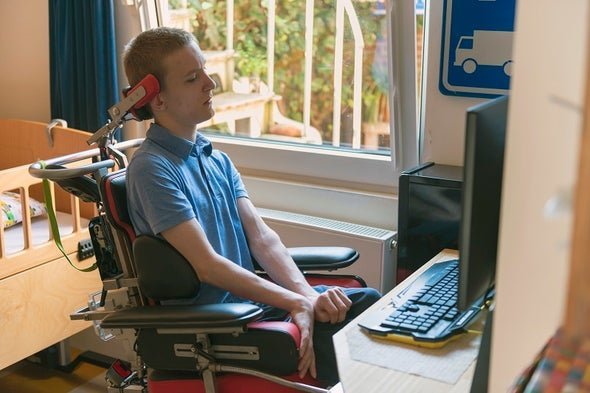Artificial Intelligence Helps Deciphering Amyotrophic Lateral Sclerosis

Machine learning techniques are helping researchers identify 690 genes that are linked to the deadly disease, which affects neurons that feed muscles in particular. Artificial intelligence helps deciphering amyotrophic lateral sclerosis "Yasser" did not imagine that the cramps and spasms that afflicted his hand and arm could change the course of his life. The former athlete, who was just over forty years old, attributed these cramps to the mental stress and physical exertion he was exerting, and when he sought the advice of some of his friends in the medical field, they advised him By conducting a set of analyzes and obtaining calcium, vitamin B12 and vitamin D tablets. "Yasser", who refused to give his full name, said in statements to "Al-Alam": The results of the analyzes did not show any problem, although the symptoms began to increase, and simple tasks such as closing shirt buttons or opening cans became difficult for me to do, the symptoms extended to The lower extremity, maintaining balance became very difficult, walking was a heavy burden, and holding things by hand was a dilemma, and in the end, after visiting several doctors, I was diagnosed with “amyotrophic lateral sclerosis”, a disease I was hearing about for the first time in my life. amyotrophic lateral sclerosis Amyotrophic lateral sclerosis gradually affects the movement nerves, and affects the nerve cells in the brain and spinal cord, causing the patient to lose muscle control. The famous British theoretical physicist “Stephen Hawking” is one of the most famous personalities who fell ill for about 55 years, and the disease is also called “Lou Gehrig’s disease” after the American baseball player who was diagnosed with it in 1939 and led to his death in 1941 at the age of He is 37 years old. Fortunately, it is not a common disease, affecting about six people out of every 100,000, but unfortunately, doctors do not know why it occurs. But a recent study published in the journal Neuron, the results of which indicated that we may be on a date with additional understanding of the genetic factors that are associated with the occurrence of amyotrophic lateral sclerosis; Researchers have identified a gene related to neuronal toxicity and, subsequently, disease-related developments. The study notes that "although genetic factors cause 52% of cases of the disease, this aspect is not well understood." The research team worked to understand the mechanisms of the occurrence of this deadly disease through the use of "artificial intelligence", and designed a technology called (RefMap), and according to the study, this technology aims to identify different genetic variants in the active genome regions (both those that contain a code to produce This process is carried out on a large scale in regions of the genome in order to determine the possibilities of an association between a particular disease, on the one hand, and variants present in each region, on the other. The researchers relied on the "Whole Genome-wide Association Studies" (GWAS) methodology, which allows scientists to search thousands of individual genomes to discover genetic variants associated with specific traits. cause of this disease. genetic data analysis The research sample included 5594 patients with amyotrophic lateral sclerosis, and 2238 healthy people who represented a "control group". All of them were genome analyzed. The research sample included participants from several different nationalities, American and European. The researchers first identified 690 genes in neurons from iPS cells — a type of cell produced from adult somatic cells that have been genetically reprogrammed to a state similar to embryonic stem cells. These cells can produce different types of cells - and these genes have been linked to the disease, and in total cause the risk of inheriting the disease up to fivefold. The researchers further analyzed the genetic data and studied the functions of these genes in the neurons of patients and healthy people, which helped them identify one of the most important genes involved in the disease, known as KANK1, and this gene is linked to the occurrence of many brain diseases such as spastic quadriplegic cerebral palsy and autism disorders. Using artificial intelligence techniques, the researchers found that this gene is associated with amyotrophic lateral sclerosis, and in order to confirm these results, the researchers made a mutation in the KANK1 gene in healthy neurons, which led to a toxicity in neurons, and also led to the emergence of a protein TDP-43 and its aggregation in neurons. The presence of this protein is a hallmark of many neurological diseases, including amyotrophic lateral sclerosis; Normally, this protein plays a role in RNA stability and translation, but it accumulates abnormally when these diseases occur.
gradual loss
For her part, El-Shaimaa Sobhy, professor of clinical physiology of the nervous system at Cairo University’s Faculty of Medicine, explains that “amyotrophic lateral sclerosis is one of the neurodegenerative diseases, diseases that are characterized by a gradual and increasing loss of the structure or function of nerve cells, which may eventually lead to death. nervous cells".
Sobhi said in statements to Al-Alam: This disease affects the nerve cells that feed the muscles in particular, and causes symptoms that vary according to the location of the nerves and muscles affected by the disease. It spreads to other parts, even affecting the muscles of speech, chewing and swallowing.
She adds: We don't know much about this deadly disease, but the average patient survival period ranges between 20 to 48 months from the date of infection, and only 10-20% of patients can survive for 10 years after being diagnosed with the disease. Unfortunately, there is also no specific treatment that can stop these changes, so any addition that can help understand this disease or represent a therapeutic target is a very valuable step.
In turn, Maha Emad, a professor of physical medicine, rheumatology and rehabilitation at the Faculty of Medicine at Suez Canal University, said in statements to Al-Alam: The study provides new information about the role of genetics in amyotrophic lateral sclerosis, and represents a step towards understanding how the disease is transmitted from one generation to the next. And this step may be followed by other steps to identify the possibility of people contracting the disease, diagnose it early, and provide early treatment opportunities that lead to better results.
step on the way
The study's findings are just a step along the way, said Alasdair McNeill, a consultant geneticist at Sheffield Children's Hospital and a teacher of neurogenetics at the University of Sheffield in the UK, who was not involved in the study. "The researchers used a new and distinct method of machine learning to Analysis of the complex genetic data associated with disease.
McNeill said in statements to "Science": These techniques helped to identify many new genes that play a role in this disease, and avoided useless data, as confirmed previous results related to how the disease occurred, and also contributed to the identification of a new gene that can To be a target for further study, and may be used in the future in the genetic diagnosis of the disease, but despite the value of these results, it is not certain that these results will contribute to the identification of new therapeutic targets, and further study is needed to verify this benefit.
In turn, Emad says: “Expanded association studies at the genome level represent the basis for precision or personalized medicine, in which the patient receives treatment according to his own genes, and as these studies grow and use different techniques to analyze the resulting data, we may be able to identify patients at risk The incidence of amyotrophic lateral sclerosis and intervention in order to resolve the battle early without huge losses.
That's what we're aiming for, Snyder comments, and our efforts will not stop when KANK1 is identified as a disease-related gene. We plan to identify other genes, and through this research we aim to build models that can predict ALS, but we also plan to use the same technique for other neurological diseases to understand its causes.





